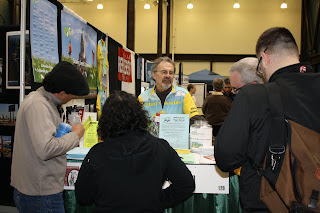I’m a new contributor to the Bicycle Alliance blog, so I should probably introduce myself. The basic facts:
Name: Dave Shaw
Residence: Capitol Hill, Seattle
Age: 64
Cycling since: 1973
Number of bikes: 2
Number of cars: 0
I was involved in the formation of the Northwest Bicycle Federation (NOWBike) the predecessor of Washington Bikes. I attended the first BAW auction, and I still own a NOWBike T-shirt. Currently I volunteer, mostly as the resident geek. I have participated in most of the varieties of cycling – recreational, racing, long distance touring, utility – and have worked in the sport as a race and event promoter, and publisher of The Bicycle Paper. Many years, many miles.
Out of all those miles some rules of thumb have emerged:
• A split second is the time between when you unclip your foot from the pedal and when the light changes.
• If you ride south in the morning, the wind will blow from the north in the afternoon.
• Twelve miles an hour is about the best speed you can make through city traffic however fast you sprint between traffic lights.
• The optimal seat tube length for your road bike is equal to the circumference of your head less 2 cm. (Credited to Bill Ferrell, developer of the Fit Kit, in the catalog of The Third Hand of Ashland, Oregon.)
• The sum of the weight of your bike and the lock you would use to secure it on a college campus is a constant.
• When you take a long trip, plan only half of it and leave the other half open for enjoying surprises.
• Pace lines are fastest with 4 to 6 bikes. Fewer is not enough horsepower, more riders increases the chance of a pace-breaking disruption.
• The batteries in your lights never go flat when the bike is at home.
• Add an hour to your usual check-in time at the airport if you are bringing a bike.
• A bike shop will take twice as long to true your wheel if you have worked on it first.
• If there are n types of tires in your group, there will be n-1 types of spares. The nth person will get a flat.
• For in-town trips less than about 3 miles, a bike will be faster than either a car or the bus door-to-door.
• Soon after you first adopt cleated shoes, you will have a “falling down story.” It happened to all of us.
• Saddles don’t “break in,” butts do. If your saddle hurts after 20 or 30 miles, get one that fits you. You’ll know it’s right if it doesn’t hurt.
• When a local person gives you directions like “Just down the road a mile,” it won’t be either down or a mile.
• Maximum heart rate is 220 minus your age. Optimal training rate is 80% of that. It will hurt to go that fast.
• A “quick stop” on a group ride is 5 minutes times the number of people. Double that if it’s raining.
• Often is better than long. Five 10-mile rides each week will do your training more good than a half-century every Saturday.
• No matter how many bikes you have in your basement, at least once a year they will all have a flat tire simultaneously.
• Bikes go faster when they are clean. (That’s my excuse for going slow.)
• No matter how many times you check the list, you will forget something. The best you can hope for is that it will be something you can replace at your destination.
• Starting about March, all the hills in the world flatten out slowly. Somewhere around November they start getting higher and steeper again, reaching a peak just before your first ride of the season. This is a known physical fact.
Who else has a favorite rule of thumb?





